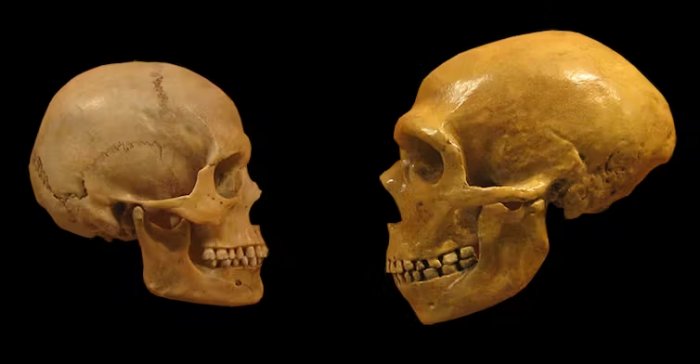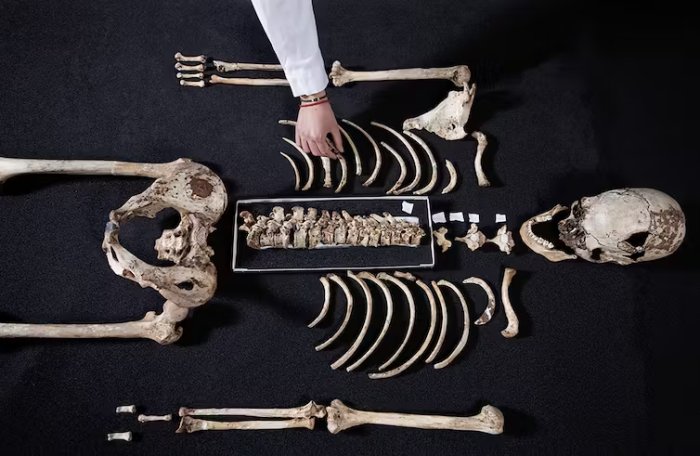AncientPages.com – When researchers used DNA from the 10,000-year-old “Cheddar Man”, one of Britain’s oldest skeletons, they unveiled what the first inhabitants of what now is Britain actually looked like. But this isn’t the first time DNA from old skeletons has provided intriguing findings about our ancestors. Rapid advances in genetic sequencing over the past few decades have opened up a whole new window into the past.
1. Our ancestors had Sєx with Neanderthals

The look of love. Human and Neanderthal skulls. DrMikeBaxter/wikimedia, CC BY-SA
Archaeologists have known for some time that modern humans and Neanderthals lived together in Europe and Asia, but until recently the nature of their cohabitation was unknown.
In fact, after the first full Neanderthal mitochondrial genome (DNA located in the cell’s mitochondria) was sequenced in 2008, there was still uncertainty among both archaeologists and geneticists as to whether humans interbred with our closest relative.
When the full genome of a Neanderthal was sequenced in 2010, comparisons with modern human DNA showed that all non-African people have pieces of Neanderthal DNA in their genomes. This could have occurred if humans and Neanderthal had interbred around just 50,000 years ago, a result that was confirmed a few years later.
2. Interbreeding enabled Tibetans to live in mountains
Amazingly, it wasn’t just trysts with Neanderthals that kept our ancestors busy. When DNA was sequenced from a fossilised finger from a cave in the Altai mountains of Siberia, which was thought to be Neanderthal, genetic analysis showed that it was actually a new species of human, distinct from but closely related to Neanderthals. Analysis of its full genome showed that these “Denisovans” also had Sєx with our ancestors.
Tibetans, who live among some of the highest mountains in the world, are able to survive at alтιтudes where most people are encumbered by the lack of oxygen. Genetic analysis has shown that Tibetans, along with Ethiopian and Andean mountain dwellers, have special genetic adaptations that allow them to process oxygen in this rarefied mountain air.
We now know that these genetic adaptations to alтιтude in Tibetans – they have a specific variant of a gene called EPAS1 – were in fact inherited through ancestral mating with Denisovans.
It turns out that improvements in immunity, metabolism and diet among modern humans are also due to beneficial genetic variants inherited through this interbreeding with both Neanderthals and Denisovans.
3. Our ancestors evolved surprisingly quickly
Interbreeding accounts only for a tiny amount of human adaptation around the world. Analyses of DNA are showing us that, as our ancestors moved around the world, they evolved to different environments and diets far more quickly than was originally thought.
For example, the textbook example of a human adaptation is the evolution of lactose tolerance. The ability to digest milk past the age of three is not universal – and was previously ᴀssumed to have spread into Europe with agriculture from the Middle East starting some 10,000 years ago.
But when we look at the DNA of people over the past 10,000 years, this adaptation – which is now commonplace in northern Europe – was not present until around around 4,000 years ago, and even then it was still quite rare. This means that the spread of lactose tolerance across Europe must have occurred incredibly quickly.
4. The first British people were black
DNA from one of Britain’s fist people, Cheddar Man, shows that he was very likely to have dark brown skin and blue eyes. And, despite his eponym, we also know from his DNA that he couldn’t digest milk.

Cheddar man skeleton. Channel 4
While it’s fascinating, and perhaps surprising, to learn that some of the first people to inhabit the island that is now known as Britain had dark skin and blue eyes, this striking combination is not altogether unpredictable given what we’ve learnt about Paleolithic Europe from ancient DNA. Dark skin was actually quite common in hunter gatherers such as Cheddar Man who were living in Europe in the millenia after he was alive – and blue eyes have been around since the Ice Age.
5. Immigrants from the East brought white skin to Europe
So, if dark skin was common in Europe 10,000 years ago, how did Europeans get their white skin? There are no hunter gatherers left in Europe, and very few remaining around the world. Agriculture has replaced hunting as a way of life, and in Europe we know that farming spread from the Middle East. Genetics has taught us that this change also involved significant movement of people.
We also now know that there was also a large influx of people from the Russian and Ukrainian Steppe around 5,000 years ago. As well as DNA, the Yamnaya people brought domesticated horses and the wheel into Europe – and maybe even proto-Indo-European, the language from which almost all modern European languages originate.
A good bet for where white skin came from is that is was introduced by either the Yamnaya or Middle Eastern immigrant groups. It will have then become ubiquitous as a result of its benefit as an adaptation to low levels of sunlight – light skin pigmentation is thought to help people better absorb sunlight and synthesise vitamin D from it.
Written by George Busby, Scientific Product Manager, University of Oxford Sydney
Provided by The Conversation
This article is republished from The Conversation under a Creative Commons license. Read the original article.





